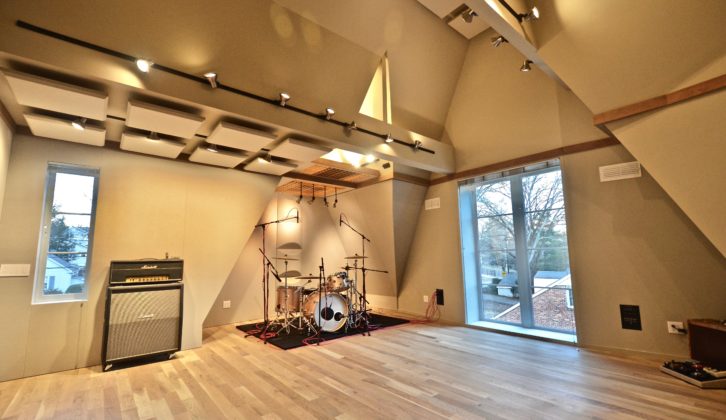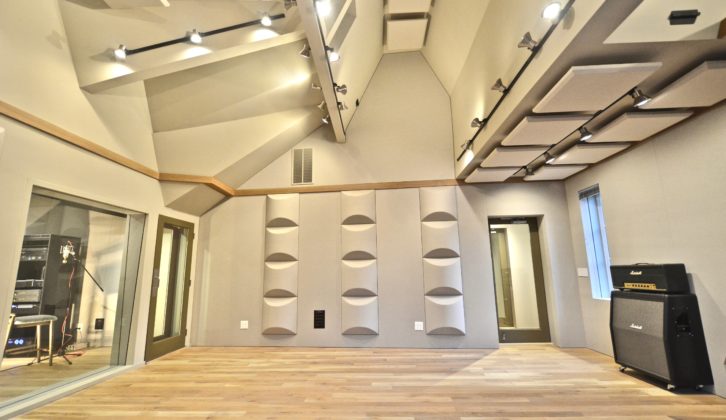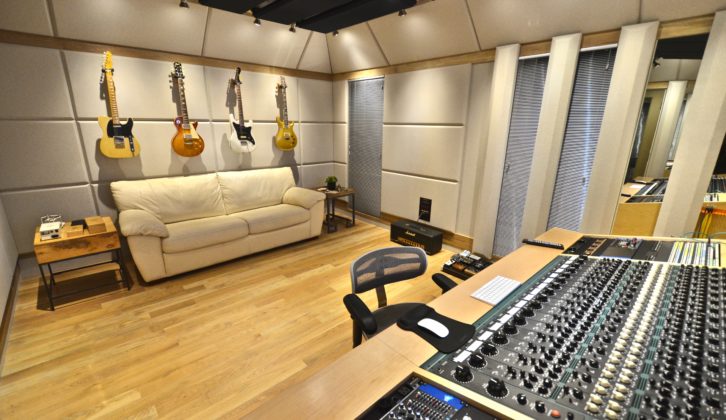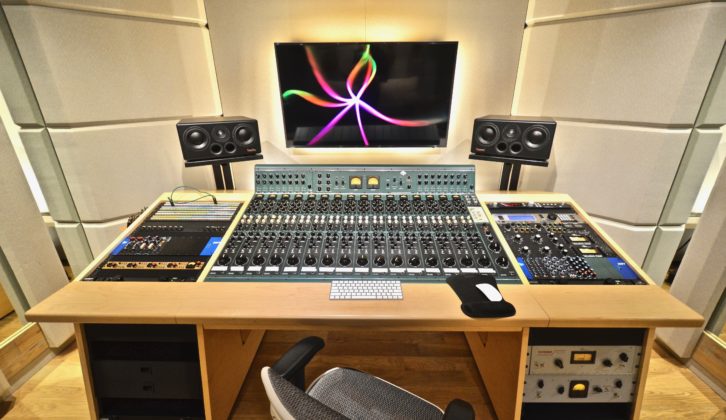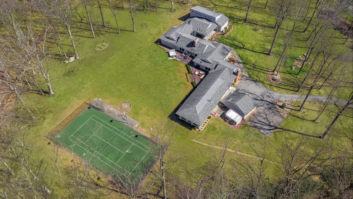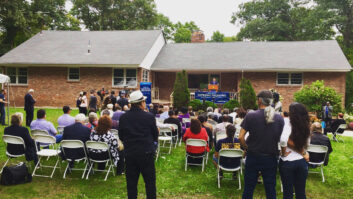Nashville, TN (November 29, 2018)—He plays guitar and drums and is a fan of classic rock, but the owner of The Upper Deck—who wishes to remain anonymous—is a Major League Baseball player who spends his summer months on the diamond. A music hobbyist since his teens, he brought in Carl Tatz of Carl Tatz Design (CTD) in Nashville to transform the upper floor of the home where he spends the rest of the year into a professional-grade control room and tracking space that also houses his guitar and amp collections.
“It was just an attic, framed out,” Tatz recalls of his initial site visit. “I walked into the tracking room and said, take these 9-foot joists out and we could take advantage of the 18-foot ceiling.”
Inside Upper Deck’s Live Room.
Inside Upper Deck’s Live Room.
Inside Upper Deck’s Control Room.
Inside Upper Deck’s Control Room.
Incorporating several large, immovable beams, it was a Rubik’s cube of a space in which to design a studio, he says. “I would stand there, fold my arms and say, what the hell am I going to do with this thing? But ultimately, I knew it was going to be a tremendous tracking room. It really sounds amazing; very neutral, which is what I go for.”
There were more challenges. The house is in a residential area, so the studio had to be soundproof. Tatz’s designs feature a room within a room, sandwiching a layer of 3/4-inch MDF and two layers of 5/8-inch sheetrock, a tricky proposition with the nooks and crannies of the high-ceilinged space.
“Because Nashville is booming, it was hard to get the drywallers to do it. These crews would walk into the middle of the room, look at the ceiling and go, ‘Nope.’ And they’d leave, because they could make the same money doing an 8-foot bedroom. So it took a couple of months longer to get it done,” he reports.
Other people might have done less acoustically, he says. “But I have to remind people that you can’t take reverb off—well, not in an easy or desirable way.”
The intersection of the various planes of the multi-gabled roof enabled Tatz to create a permanent spot for drums. “The drum alcove is amazing sounding. It almost acts like a booth.” Three stereo pairs of Crown PZM microphones, above the drum kit and in two areas of the high ceiling, all come up on the patchbay.
Then there was the huge tracking room window. Tatz typically takes a more expensive route, using a single pane on the room side of the air gap, with no trim, because he prefers the cleaner look, even though it takes more finessing. The 3/4-inch-thick glass weighs 800 pounds, he reports, and took an $1,800-a-day forklift and six guys with white faces and white knuckles to position it. One mistake, says Tatz, “and you’re going to lose a foot.”
The floorplan was an additional challenge. “There’s a stairwell in between the control room and the tracking room. That became an entrance foyer, booth and machine room, so I had to make sure that anything in the rack was quiet.”
Tatz is known for his control rooms, which are centered on his precision PhantomFocus System (PFS). “The monitoring is the whole thing for me,” he says. “I design the room around the monitoring.”
The Upper Deck’s system comprises a pair of Carl Tatz Design PFM HD bi-amp monitors, a pair of PFM ICE Cube-12 subwoofers, a PFS 4800 digital processor, four PFM MonoBlock 2200 amps and PFS Monitor Stands. As with all Tatz PFS monitoring set-ups, it also includes a PF eChair.
Why two subs? “If you put a pair of monitors on stands behind or on top of a console, it doesn’t matter what room it is, or what monitors they are, they all drop off drastically—10 dB—at approximately 125 Hz,” Tatz explains. “Then they come up to some degree at the low end of the speaker, around 40 or 50 Hz. There’s a Grand Canyon of missing information. The subwoofers fill in that dip.”
Carl Tatz Signature Series acoustic modules by Auralex are used throughout the facility. The control room further benefits from a cavity at the rear that provided space for Tatz’s axial mode absorber. “The bass trapping in that room is unusually good,” he says.
Ordinarily, the PFS equipment list would include a Carl Tatz Edition Argosy Console. But the owner had selected a 16-channel Tree Audio Roots Generation II mixing desk for the room, which features a prominent meter bridge. “I tried to get the console as low as possible, because the mixing desk comes up so high; I hate that for monitoring,” says Tatz, who had Nashville’s Sound Construction and Supply build a custom console.
The console rack space is well stocked with outboard recommended by the owner’s friend, including two API 500 series lunchboxes, a Briscasti M7 stereo reverb processor, Eventide H8000FW multichannel effects system and other goodies.
Bob Bullock, owner of Cool Springs Mix and an engineer and producer who has worked with Shania Twain, George Strait and Reba McEntire, has had Tatz build mix rooms for him at three different locations. Initially visiting The Upper Deck to check out the latest example of Tatz’s studio design work, Bullock, who is also an educator, reports that he has also spent time tutoring the owner on music production.
“It’s a Carl Tatz PhantomFocus control room, which I’m very familiar with, which means it’s got extremely accurate imaging and all that,” says Bullock, “but the recording space is also very professionally done, with great isolation.”
The owner tracks to Pro Tools with live musicians, rather than programming MIDI tracks, says Bullock, who has taken a similarly old-school approach to production for the past 25 or 30 years. “The client went with being able to record more organic sounds. There is some analog gear in there for the recording process to give you that hybrid of analog and digital recording and mixing,” he says, “and the desk sounds really good.”
Carl Tatz Design is nominated for The Upper Room in the Studio Design category of the 34th Annual TEC Awards, which will be presented during the 2019 NAMM Show.
Carl Tatz Design • www.carltatzdesign.com
